'Airplanes bring us together': Ahead of 50th Sun 'n Fun, ruminating on a life of aviation
Since its humble launch as a single weekend fly-in event in January 1975, Lakeland’s Sun ‘n Fun Aerospace Expo has grown exponentially.
Last year’s attendance included 200,000 visitors and 3,000 airplanes. The direct economic impact of all that activity is immediate, impressive and widespread. Tens of millions of dollars flow into communities from Winter Haven to Plant City and beyond for airport services, hotels, restaurants, car rentals, short-term home rentals, gas, groceries, souvenirs and much else.
In addition, thousands of in-person customers buy from hundreds of vendors who exhibit during the show.
Quite apart from its role as an economic volcano – and a hugely important one since it supports the aviation academy – the annual airshow brings people together in a very real sense to marvel at the spirit and mystique of flight, allowing imaginations to soar above the mundane and the everyday. Blessedly absent is the poisonous atmosphere of politics. The airshow literally soars above it.

With a degree in aviation management from Ohio State University, Eugene B. “Gene” Conrad was Lakeland’s airport director for 12 years until he took over Sun ‘n Fun in 2022 at the retirement of John “Lites” Leenhouts, a former Naval aviator who had resuscitated and rebuilt what had been a failing organization.
Now Conrad – a dynamic 48-year-old who was raised around airports – leads the 50th annual show, which takes place April 9-14.
Q. Aside from what's on your resume, what might people be interested in knowing about you?
A. I was born in Oshkosh, Wisconsin – where I’ve volunteered for 35 years – and I grew up around the Experimental Aircraft Association. I've been around aviation my whole life, starting with my dad's career as an airport manager at Oshkosh, then at Huntsville, Alabama, and Worcester, Massachusetts. I always knew I was going to be in aviation.
Q. In terms of attendance and number of planes, the biggest air show in the United States – and for that matter, the world – is AirVenture held each summer in your hometown. More than 10,000 planes and 677,000 people attended last year. Are there any aspirations among your board of directors and/or you to one day overtake Oshkosh as the number one air show in the country?
A. We will never be the size of Oshkosh because they have so much acreage. We have about 800 acres that we operate on during the event. I don't know how much AirVenture has, but it's much, much more. And our goal is not to beat them. We operate at different times of year, so we're spring break for pilots when everybody wants to come down here to our southern hospitality while they're still dealing with the weather up there.
And they're a membership organization – they have 250,000 members and we don't have that. We're completely different, but they are great show and we're a great show and we support them and they support us, so it's a good partnership.
Q. Just about two years ago you succeeded “Lites” Leenhouts as executive director. What has remained the same and what has changed?
A. The biggest thing is the tempo – we're just moving with a much quicker pace on what we need to do because it's not only the flying, it’s what we do the other 51 weeks out of the year with all of our educational programs.
This event is really focused on the customer service experience – whether our guests are flying in or driving in or they're camping with us. And we've never had as many exhibitors – we’re sold out completely – with 563 exhibitors occupying 805 spaces.
Q. Lakeland Linder airport, which has its origins as a World War II training base, has grown tremendously of late. Amazon planes, as well as corporate jets, arrive and depart with great frequency. This has raised concern among neighbors old and new about noise levels, which will only be exacerbated during this event. What if anything is being done to address those issues during Sun ‘n Fun
A. I'll be honest – we can't do much because of the volume of aircraft that are coming in and the special approaches and procedures that are in place. Unless you just moved to town, you know about Sun ‘n Fun – it's a big event with lots of airplanes. But it's six days and it's over.
'Something that speaks to them': The building of a world-class art museum in Lakeland
There are about 530 towered airports in the United States. Lakeland Linder is the 98th busiest and it's not just Amazon. Of the 157,000 operations last year, only about 8,500 were theirs. The rest is general aviation activity – business jets, flight schools, itinerant operations. There are just a lot of people moving to Polk County and Central Florida and it's reflected in airport activity. In 2010, total operations for the airport were about 64,000 and now it's about 157,000 annually, which is great – that's what it's all about.
Q. Sun ‘n Fun has an excellent safety record, but with so many planes and pilots participating there are simply many things outside your control. What types of emergencies are you prepared to address should they arise, and how many of your staff are solely dedicated as emergency responders for this event?
A. We're very fortunate because we have the Sheriff's Office, Lakeland Police Department, Lakeland Fire Department and Polk County Fire Rescue. All of those entities are out here if God forbid there is an issue. The airport is part of this team and we respond accordingly, but we basically let the professionals respond to those things because that's their job, that’s what they do and that's why they're here. They have a massive compound with a lot of people and all the equipment, so we just stay out of their way.
It's not only the aircraft, we have people driving, and we have our campgrounds with thousands of people out there, so we have a little city right here on the airport. Hopefully we’ll have zero incidents – that's the goal.
Q. Though many people are unaware of it, Sun ‘n Fun’s reason for existence is to financially support the Aerospace Center for Excellence. Describe what ACE is all about and give your evaluation of its progress and ambitions for the future.
A. There's always been an element of Sun ‘n Fun that was about the youth and bringing up the next generation. Our educational programming here really started to take off with the Central Florida Aerospace Academy in 2008, a high school concentrating on STEM – sciences, technology, engineering and math. It’s the anchor for the Aerospace Center for Excellence, which includes outreach to over 30,000 students annually. The fly-in generates almost 80% of the revenues for the Aerospace Center, which means our net proceeds from the fly-in each year are going back into our educational programming.
There are many different career paths in aviation, from pilots to aerospace engineering, drones, avionics, air traffic control, aviation mechanics and business management. Among other things, we provide scholarships for kids to get their private pilot certificate.
There are a lot of jobs available in the industry. As far as the magnitude of what we've created and just the mass of all of these programs I don't believe it exists anywhere else in the United States.
Q. Besides other goals, ACE claims to produce more teenage pilots than anywhere else on Earth, which might give some folks pause. Is it fair to say these students are more mature and focused than most?
A. Yes, because it’s not easy. It takes time and dedication. These are very focused individuals. We’ve produced 175 certificated pilots through our scholarship program, and at any given time there are 30 to 40 kids in the program. We stay on top of our kids, we mentor them – it's not just give them money and say “good luck.” We want to make sure they’re successful.

Q. As you mentioned, this event is informally known as “spring break for pilots.” What specific steps would you advise private pilots to take before attempting to land in such a crowded airspace?
A. I tell everybody coming in to read the Notams (Notice to Air Missions, formerly known as Notice to Airmen) – they’re the bible – and listen to the queues from the tower because we have a brand-new approach this year. It gets really condensed.
Q. And of course like at the main Lakeland airport itself, air traffic controllers are essential to sequencing traffic.
A. If I didn't run airports and I had to do it all over again, I would be an air traffic controller because I just love the airspace and how it all works and the choreography. Essentially, it's a ballet. During this event, the FAA brings in anywhere from 60 to 70 controllers from around the U.S. to operate our event. Right after an air show, we sometimes have 300 airplanes depart in about 45 minutes, and they’re really close together. In that time period, we're probably the busiest airport in the world.
Q. It’s not a part of your job description, but are you a pilot?
A. Not yet. A lot of people on my team don't fly but are passionate about aviation. But I'm working on it. I'm in ground school right now, and I want to do it just for the fun. I don't have boats and I don't have Harleys, My passion is my work. I love this stuff, and I get to be around it every single day.
'Kids are a lot more sophisticated" Jean Reynolds on book banning and standards
Q. Aside from your paid staff, how many volunteers help make Sun ‘n Fun possible?
A. For the first 10 years, there was not a paid employee in this organization. Over the last 50 years, we have on record over 20,000 volunteers who have helped us put on this event. This year, we'll have over 2,900 volunteers to help us. We would be nowhere without them – they are the lifeblood of what we do.
Q. What would you like folks reading this to know that hasn’t been discussed?
A. The gates open at 9:00 and there are all sorts of activities throughout the day and then the daily air show starts at 1:00 and goes till 5:00. Each evening there’re activities and entertainment as well. There's something for everyone, especially the kiddos. Last year, we had over 15,000 youth tickets. Ten and under is free, and 11 to 17 is $20, so it’s very reasonable for a family.
I love this stuff, and I love the family aspect. Airplanes bring us together, but it's the people that keep us coming back because of all the friendships built here – the camaraderie of like-minded people. We all love aviation, we all want to see it flourish – and it's just a great time to be around friends and family and enjoy six days of fun.
This article originally appeared on The Ledger: Ahead of 50th Sun 'n Fun, Gene Conrad ruminates on a life of aviation

